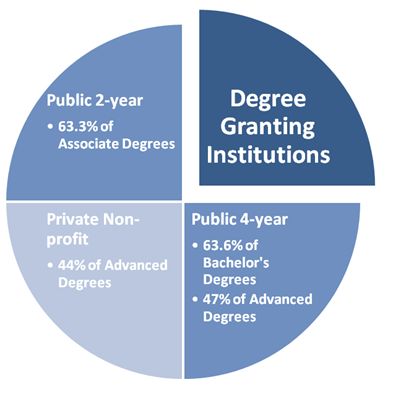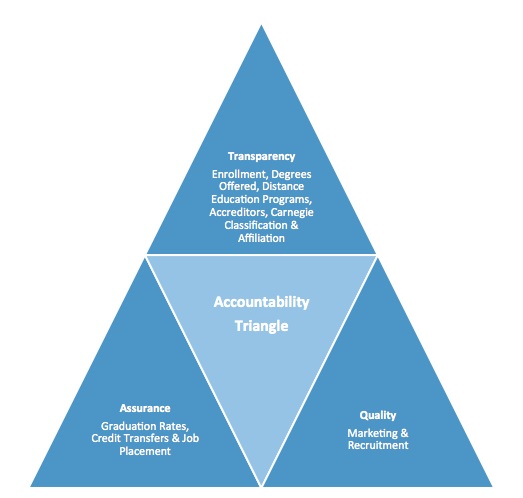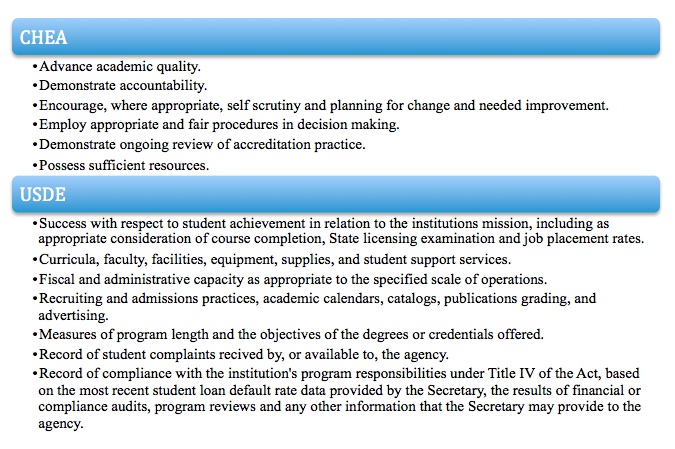Pillars of Accreditation
Accredited institutions share a level of quality that certifies they have the standards necessary to provide a quality education. They have all received accreditation by rising to meet the standards set by the accreditors who have been recognized by either the CHEA or USDE. For an accreditor to achieve recognition, they must meet the standards set by an external agency.
The standards set by the CHEA and USDE reflect very different priorities. The standards set by the USDE pay special attention to student recruitment, admissions and success. Whereas, the standards of the CHEA concentrate on courses and degrees offered.
In the most survey conducted the USDE, there are more than 21 million students currently enrolled at degree granting institutions in the United States. On average only around 35 percent of enrolled students earn their degree in the estimated time it should take.
 CHEA accredited institutions have demonstrated practices that advance current standards of learning. They have also proven themselves accountable to the public for their promises. Lastly, they have shown a willingness to accept change where it is needed and plan for improvement.
CHEA accredited institutions have demonstrated practices that advance current standards of learning. They have also proven themselves accountable to the public for their promises. Lastly, they have shown a willingness to accept change where it is needed and plan for improvement.
Institutional advancements in academic quality are based on high standards of student success. To ensure that students are reaching their potential, particular attention is paid to the teaching, learning and research services offered by an institution.
Institutional accountability is proven by good communication. An organization must be clear in their intentions and reliable in communicating them to the public as well as to organizations of higher education. A commitment must be shown to decisions made and there must also be honesty and consistency with any results regarding their academics efforts.
These institutions are held accountable for student achievement and the factors that influence it. The first piece of accountability is transparency. Institutional and accrediting information should be easily accessible and understandable. The second factor of accountability is quality. Institutions are held accountable for the standards they set. Holding institutions accountable for their quality protects students from false marketing and recruitment practices.
The final piece of the accountability triangle is assurance. This assurance comes in the form of evidence. Institutions should collect and analyze information regarding their graduation rates, credit transfers and job placements. This information assures that the institution is working to meet their set goals for and improve student achievement.

Institutions must demonstrate an ability to adapt and prepare for the future. They must be open to change and prepared for potential improvements. Accredited organizations have proven themselves capable of planning, developing and sustaining programs that continually adapt and change to improve student learning.
Changes are made based on analyzed results with the intention of improving student success. Organizing and analyzing the factors that measure student achievement can lead to changes within a program or even changes in pedagogy or teaching practices.
USDE accreditation standards overlap with those defined by CHEA. An institution’s curriculum, faculty and facilities are important to both USDE and CHEA accreditation. These are the primary factors that influence teaching and learning practices and are used to determine an institution’s academic quality. Recruiting methods and job placement are also shared standards between the CHEA and USDE. The CHEA groups these terms with an organization’s accountability. CHEA accreditation standards require than an institution define ambitious goals. These goals are recognized by the USDE as objectives of an institution’s program duration and degree intentions.
Demonstrating the ability to continually improve from goals and research is a unique requirement of CHEA standards. USDE standards do not acknowledge plans for improvement. However, they do include an institution’s promise to adhere to Title IV responsibilities. Institutions accredited by the USDE may receive government funding and accept financial assistance. The Title IV standard ensures that an institution is using the funds appropriately and protects students with financial aid.

